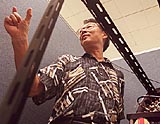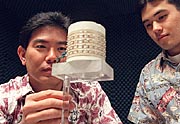 Big potential for UH research Big potential for UH research
By John Duchemin
Advertiser Staff Writer
When Aquasearch looked at University of Hawai‘i Professor Richard Moore's blue-green algae collection, the Big Island biotechnology company saw gold.

|
| Professor David Y.Y. Yun, a world-class telemedicine researcher, has corporate financing and joint-venture support for several of his projects.
Jeff Widener • The Honolulu Advertiser |
Moore’s single-celled organisms, gathered from around the world, had already yielded cryptophycin, a chemical compound licensed to drug maker Eli Lilly as a potential cancer fighter. Aquasearch scientists hoped to mine the microscopic plants for more hidden value and, in 1999, offered to finance Moore’s lab and to give the university a share of any profits.
But Aquasearch’s excitement dimmed as it grappled with university officials over contract terms. After months of negotiations, the company gave up. Only after the university overhauled its Office of Technology Transfer and Economic Development last year did Aquasearch try again — and succeed in January after a few months of tinkering.
"The change was like going from night to day," said David Watumull, a former Aquasearch official who helped land the deal. "Two years ago, the university’s stance was to protect itself at all costs. But now, it seems they’ve had a significant change in attitude."
The Aquasearch deal, a debacle transformed into a success, represents what some say is a turning point for the university as it tries to become a center for technology research. In addition to overhauling its key technology-transfer department, it has recently taken steps to maximize its potential both as a world-class center for academic research and as a producer of top-flight, commercially applicable technology as part of a broader push to improve the UH research climate.
All aspects of research — from administrative changes and fiscal reforms to lab-equipment procurement processes — are being tweaked. The university is also trying to create a more entrepreneurial climate with hires aimed at putting forward-thinking administrators in key positions — with Dean David McClain of the College of Business Administration and Dean Edwin Cadman of the John A. Burns School of Medicine as two oft-cited examples.
And the school is seeking better relations with technology business leaders, who can be critical in the transfer of intellectual property from school to industry. Programs including University Connections, a 2-year-old networking group of UH officials, professors and business people, are designed to build a "community of practice" around the university tech research scene, McClain said.
If the university succeeds in its efforts to identify its best research and promote "technology transfer" from professors’ labs to private companies, experts say UH could become a magnet for more top-notch researchers, breed more breakthrough ideas, sign more lucrative licensing deals, and help create companies that would cause Hawai‘i’s fledgling technology industry to take off and play a greater role in the state’s economy.
"Nearly every place that has truly flourished in technology has a major university associated with it acting as a source of research," said Stefan Moisyadi, research coordinator for the university’s Institute for Biogenesis Research. "So the state cannot expect to develop a technology industry without a strengthened University of Hawai‘i. If we don’t have that, we’ll be back to sugarcane and tourism."
Yanagimachi’s mouse
 |
| In one of many technical research projects at the University of Hawai‘i, Professor Wayne Shiroma and electrical engineering student Kendall Ching work on perfecting a quasi-optical transmitter.
Jeff Widener • The Honolulu Advertiser |
The potential is clearly there, Moisyadi and others say. The University of Hawai‘i for decades has been a source of scientific innovations, some famous — Ryuzo Yanagimachi’s mouse-cloning technique is one of the most recognizable examples- but most low-profile. As an officially designated research university, UH has attracted hundreds of millions of dollars’ worth of research grants in recent years — including a record $103 million in 2000.
Many recent research breakthroughs also hold tantalizing commercial potential. Several electrical engineering professors are perfecting broadcasting methods for previously impractical high-speed frequencies — a development that could revolutionize wireless communications. Professor David Y.Y. Yun, a world figure in telemedicine research, has four separate biomedical projects in the works, several with corporate financing and joint-venture support. Physics professor John Madey has discovered ways to produce powerful laser beams at a fraction of current costs. And Yanagimachi’s genetic research lab, with new state-of-the-art facilities and several world-class hires, continues to do pioneering research on cloning and related biogenetic processes, backed by several million dollars’ worth of National Institutes of Health grants.
Structural flaws
But despite such assets, structural flaws had long undermined the university’s potential as a wellspring for the technology industry. While the university has received millions of dollars in grants and acquired dozens of patents, it has received a mere trickle of licensing and royalty money in return.
The Office of Technology Transfer and Economic Development, the office designated to protect, market and license the university’s intellectual resources, has acquired 85 U.S. patents — each costing thousands of dollars — but has succeeded in generating revenue from only 22 of those, said Alan Tera-
mura, the university’s senior vice president for research. For the past 12 years, the university’s income from those patents has averaged only $120,000 to $150,000 per year.
"That’s not a good level to be at," Teramura said. "We’ve been putting in a lot more money than we’ve been getting out."
The Office of Technology Transfer and Economic Development has received much of the blame. Many observers, including Teramura, say the office has been inflexible, overly protective, undertrained and lacking in focus — at least until the recent reforms. But the pressure is on: After fiscal 2002, the office will no longer receive general fund money from the state, which historically has provided about $500,000 for the office’s function. That’s about one-quarter of the office’s entire budget; the rest comes from special funds.
Interim office director Edward Yuen says he hopes the office, while becoming more flexible and open, can also make up the money difference by operating more efficiently and generating more royalty revenues.
From obstacle to real help
The changes at the office are a dramatic turnaround. For much of its decade of existence, the office had been more an obstacle than an aid to technology transfer, said William Richardson, general partner of HMS Hawaii Management Partners, the most heavily financed venture firm in Hawai‘i.
"The former OTTED was very inflexible," said Richardson, who grappled with the office over the oyster-breeding technology that eventually formed the backbone of HMS-financed Kona Bay Oyster & Shrimp Co. "They couldn’t tell the difference between what was commercializable and what wasn’t; therefore they patented everything, and wasted a lot of time patenting things. Our dealing with them was a very unhappy experience."
University officials agreed. Teramura says the office has done a fine job of protecting the university’s intellectual property — but a lousy job of sharing it with businesses in a mutually profitable fashion. The result of that, Teramura said, is that dozens of patents, each costing tens of thousands of dollars to acquire and maintain, are sitting on the shelf gathering dust. And that has has made the office an eminently unprofitable enterprise, said OTTED’s Yuen, a longtime university administrator and the tech transfer office’s interim director since last year.
The reformed office promises to be far more effective, said Yuen, who has targeted several areas of improvement including more selective patenting, an increased focus on technology transfer, leaner staffing, more aggressive marketing of existing patents, and more use of consultants.
The office used to patent everything that came along, Yuen said. As a result, it spent thousands of dollars on patent applications for each item — regardless of its commercial potential. The office now plans to test the research breakthroughs in the market, share them with interested parties and line up deals — all before applying for patents, Yuen said.
The department also has shed its economic development responsibilities — now the duty of University Connections — and closed down its seed capital program. In addition, this year the office has trimmed three staff positions — their duties were reassigned to other offices -and cut about $165,000 from its operating budget, which now stands at $1.7 million.
The office also hopes to dust off its older patents, decide if they’re worthwhile, and either find a licensing partner or let the protection lapse, Yuen said. The office also plans to hire an outside firm with industry contacts to pitch UH patents in the business world, he said.
"The whole point of OTTED is to use the university’s technology to benefit the public at large," Yuen said. "So, clearly, we need to get the technology out into the marketplace. We're not going to wait around for the perfect deal anymore."
[back to top] |


